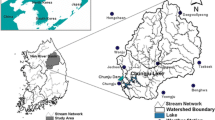Abstract
The purpose of this paper is to evaluate climate impact on snow hydrology using SLURP (Semi-distributed Land Use-based Runoff Process) model for two mountainous watersheds (A; 6661.5 km2 and B; 2694.4 km2) of South Korea. The climate change results of CCCma CGCM2 based on SRES A2 and B2 were adopted. Three sets of NOAA AVHRR images (1997–1998, 1999–2000, 2000–2001) were analyzed to prepare snow-related data of the model. Snow cover areas were extracted using channels 1, 3 and 4, and the snow depth was spatially interpolated using snowfall data of ground meteorological stations. For 4 years (1998–2001) discharge comparison, the average Nash-Sutcliffe efficiencies of A and B watersheds during the snow period (January to April) were 0.60 and 0.68, respectively. In case of A2 scenario, the 2100 runoff of A and B watersheds for 44.4% and 85.9% increase of snowfall increased 67.3% and 19.6% comparing with the 2000 runoff. In case of B2 scenario, the 2100 runoff for 10.3% and 41.3% increase of snowfall increased 38.8% and 9.8% for A and B watersheds, respectively. The results showed that the time of snowmelt runoff was advanced about one month.
Similar content being viewed by others
References
Allen, R.G., Wright, M.E., and Burman, R.D. (1989). “Operational estimates of evapotranspiration.”Agron. J., Vol. 81, pp. 650–662.
Anderson EA. (1976).A Point Energy and Mass Balance Model of a Snow Cover. Office of Hydrology, National Weather Service, Silver Spring, Maryland, NOAA Technical Report NWS 19.
Bonan GB. (1996). A Land Surface Model (LSM version 1.0) for Ecological, Hydrological, and Atmospheric Studies: Technical Description and User’s Guide. NCAR Technical Note, NCAR/TN-417. STR, Boulder, Colorado, p. 150.
Brubaker, K., Rango, A. and Kustas, W. (1996). “Incorporating radiation inputs into the Snowmelt Runoff Model.”Hydrological Processes, Vol. 46.
Douville, H., Royer, J.-F., and Mahfouf, J.-F. (1995). “A new snow parameterization for the Meteo-France climate model. Part I: validation in stand-alone experiments.”Climate Dynamics 12: pp. 21–35.
Duan, Q., Sorooshian, S., Soroosh. and Gupta, V.K. (1994). “Optimal use of the SCE-UA global optimization method for calibrating watershed models.”J. Hydrology, Vol. 158, pp. 265–284.
Glieick, P.H. (1986). “Methods for evaluating the regional hydrological impacts of global climatic change.”Journal of Hydrology, Vol. 88, pp. 97–116.
Harrison, A.R. and Lucas, R.M. (1989). “Multi-spectral classification of snow using NOAA AVHRR imagery.”International Journal of Remote Sensing, Vol. 10, pp. 907–916.
IPCC-Climate Change. (2001).Working Group II: Impacts, Adaptation and Vulnerability: Fisheries and Biodiversity. http://www.grida.no/climate/ipcc_tar/wg2/261.htm.
Jordan R. (1991).A one-dimensional temperature model for a snow cover. US Army Corps of Engineers, Cold Regions Research and Engineering Laboratory, Special Report 91-16, p. 49.
Kazama, S., Kawamura, H., and Sawamoto, M. (1995). “Snow area detection by using AVHRR NOAA.”The Remote Sensing Soc, Japan, Vol. 12, No. 4, pp. 59–69.
Kite, G.W. (1975). “Performance of two deterministic models. In: Application of Mathematical Models in Hydrology and Water Resources Systems.”Proceedings of the Bratislava Symposium, September, IASH Publication. Vol. 115, pp. 136–142.
Kite, G.W. (1993). “Application of a land class hydrological model to climatic change.”Water Resources Research, Vol. 29, No. 7, pp. 2377–2384.
Kustas, W.P., Rango, A., and Uijlenhoet, R. (1994). “A simple energy budget algorithm for the snowmelt runoff model.”Water Resources Research, Vol. 30, No. 5, pp. 1515–1527.
Leavesley, G. (1983).Precipitation runoff modelling system. Denver, Colarado, USA’ USGS Publ User manual.
Loth B, Graf H-F and Oberhuber JM. (1993). “Snow cover model for global climate simulations.”Journal of Geophysical Research, Vol. 98, pp. 10451–10464.
Lynch-Stieglitz M. (1994). “The development and validation of a simple snow model for GISS GCM.”Journal of Climate, Vol. 7, pp. 1842–1855.
Marshall S, Roads JO and Glatzmaier G. (1994). “Snow hydrology in a general circulation model.”Journal of Climate, Vol. 7, pp. 1251–1269.
Martinec, J. (1975). “Snowmelt runoff model for streamflow forecasts.”Nordic Hydrology, Vol. 6, pp. 145–154.
Martinec, J., Rango, A. and Roberts, R. (1994).Snowmelt Runoff Model (SRM) user’s manual. Geographica BernensiaReport P29, University of Bern, Switzerland.
Nash, J.E. and Sutcliffe, J.V. (1970). “River flow forecasting through conceptual models; Part 1 — A discussion of principles.”J. Hydrology, Vol. 10, No. 3, pp. 282–290.
Pollard D and Thompson SL. (1995). “Use of a land-surface-transfer scheme (LSX) in a global climate model: the response to doubling stomatal resistance.”Global and Planetary Change, Vol. 10, pp. 129–161.
Quick, M.C. and Pipes, A. (1997).UBC Watershed Model, Hydrological Sciences Bulletin, XXII.
Rango, A. and Martinec, J. (1979). “Application of a snowmelt-runoff model using LANDSAT data.”Nordic Hydrology, Vol. 10, pp. 225–238.
Rao, S.V.N., Ramasastri, K.S. and Singh, R.N.P. (1996). “A simple monthly runoff model for snow dominated catchments in Western Himalayas.”Nordic Hydrology, Vol. 27, No. 4, pp. 255–274.
SSARR. (1972).Stream flow synthesis and reservoir regulation. Portland, Oregon’ US Army Corps of Engineers, North Pacific.
Swamy, A.N. and Brivio, P.A. (1996). “Hydrological modeling of snowmelt in the Italian Alps using visible and infrared remote sensing.”International Journal of Remote Sensing, Vol. 17, pp. 3169–3188.
Verseghy, D.L. (1991). “CLASS-A Canadian land surface scheme for GCMs. Part I: soil model.”International Journal of Climatology, Vol. 11, pp. 111–133.
Walland, D.J. and Simmonds, I. (1996). “Sub-grid-scale topography and the simulation of Northern Hemisphere snow cover.”International Journal of Climatology, Vol. 16, pp. 961–982.
WMO. (1987).Water resources and climate change. Sensitivity of water resources systems to climate changes. WMO/TP, 247, 26.
Yang, D., Robinson, D., Zhao, Y., Estilow, T. and Ye, B. (2003). “Streamflow response to seasonal snow cover extent changes in large Siberian watershed.”Journal of Geophysical Research, 108(D18), 4578 doi:10.1029/2002JD003149.
Author information
Authors and Affiliations
Corresponding authors
Rights and permissions
About this article
Cite this article
Shin, H.J., Kim, S.J. Assessment of climate change impact on snowmelt in the two mountainous watersheds using CCCma CGCM2. KSCE J Civ Eng 11, 311–319 (2007). https://doi.org/10.1007/BF02885902
Received:
Accepted:
Issue Date:
DOI: https://doi.org/10.1007/BF02885902




